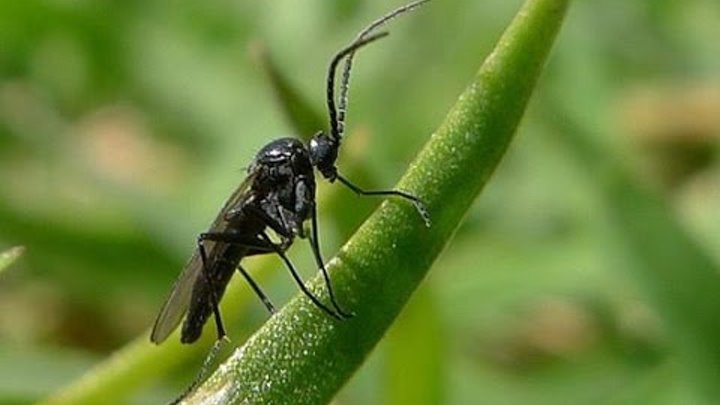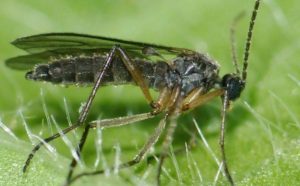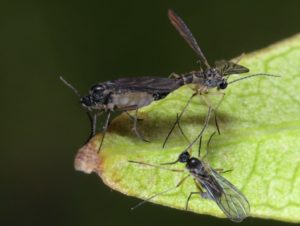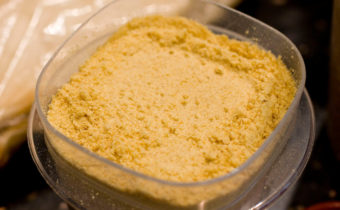Fungus mosquitoes on tomatoes

Gardeners call a mushroom or leaf mosquito, tomato front sight, detrinitsa or soil front sight a vegetable gardeners pest called sciaride. The insect belongs to the genus Diptera. Adults are carriers of fungal and bacterial diseases, but the main harm is caused by the larvae. What is the danger of a mushroom mosquito for tomatoes and how to get rid of it?
Description of the insect, the symptoms of lesions of tomatoes

The pest can appear when growing seedlings of tomatoes and after planting in a permanent place. The body of the fly is oblong to 3–4 mm. Females lay in the upper layer of the earth, especially in places fertilized with cowsweed or bird droppings, and wintering immediately passes. Larvae up to 8 mm long, white, segmented with black head, pupation occurs in the roots of tomatoes.
Inexperienced gardeners notice stsiaridov when they manage to cause significant damage. The pest is like a harmless, small fly. A distinctive feature of mosquitoes - one pair of transparent wings and a more elegant body.
The larvae feed on the roots. With a small number of pests, new ones grow to replace the gnawed roots. A large number of larvae eat up the main part of the roots, the tomatoes look oppressive in appearance, the fruits are not tied, the bushes wither. In the heat and drought of the imago, they lodge on the tops of the shoots, feed on young foliage, damage the growing point, add pathogenic bacteria and fungal spores in the tomato tissue.
Conditions comfortable for mushroom mosquitoes:
- warm and humid environment;
- places where there are vegetable, fruit and other plant residues;
- excessive watering or thickened planting.
In dry land, females do not lay, the offspring will die. The pest multiplies very quickly, in critical cases, the bushes of tomatoes dry in 2-3 weeks. But fighting insects is easy; even a beginner can handle it.
How to get rid of mushroom mosquito, prevention
If black flies appear on the seedlings, reduce the frequency of watering and the amount of water. Do not moisten the soil for a while; let the top layer dry out; do not do abundant watering when the leaves are slightly grafted. In the intervals between such irrigation, the larvae will gradually die.
Folk way of dealing with sciarides on tomato seedlings:

- soak in a glass of water 2 cigarettes (strong, without filter), leave for a day;
- close the drain holes in cups, pour the seedlings with infusion until the ground is completely wet, leave it for half an hour and open the holes;
- the next watering infusion is carried out when the top layer of soil dries out, then use ordinary water, but the frequency of the procedures remain the same.
Shallow loosening of the soil helps in the fight against the fungus mosquito; on the beds, a depth of 3–5 cm, in the case of seedlings up to 1–1.5 cm. scare away the pest.
As soon as you notice black flies flying in flocks in tomato beds, immediately begin to fight. Do not expect the stsiarids themselves to leave the garden, with a small population of significant harm to the roots, they will not cause, but the danger of contracting disease remains. We first describe the folk remedies for spraying, they can be used at all stages of growth of tomato:
- chop a glass of garlic cloves, cover with a liter of water, leave for 48 hours. Strain and dilute the extract in a bucket of water;
- Mix a tablespoon of black pepper, 3 spoons of dry mustard and 3 chopped cloves of garlic, cover with a liter of water, leave for 2 days. Strain the infusion, add 5 liters of water.
You need to spray the plants and the soil until you get rid of the pest. In infusions, you can add soap for better adhesion and enhance the effect (no more than 40 grams).
With the appearance of large colonies of the pest, when folk recipes do not give results, it will be necessary to use chemical preparations. Aktara, Aktellik, Decis, Karbofos and the biological product Fitoverm help in the fight against imago. To fight the larvae, mix Basudin or Thunder-2 with a small amount of peat or sand, scatter around tomato bushes. The protective action will last a month, then repeat the procedure.
If the insect has chosen greenhouse tomatoes, close all windows and doors, turn on the fumigator for a few hours. All the described variants of the fight against the mushroom mosquito give a good effect, but the best protection is prevention:

- sow dill between rows, it attracts insects that feed on sciarides;
- the scent of marigolds and calendula scares the midges;
- in the fall, remove all plant debris, dig up the soil on the floor of a spade bayonet, most of the larvae will die from frost;
- observe crop rotation;
- avoid excessive moisture in tomato beds;
- remove weeds, and do not put bins near the garden.
To control the appearance and reproduction of the insect can only create adverse conditions. Prevention, coupled with folk remedies, is quite enough for a successful fight against the mushroom mosquito; the use of chemicals is the last resort.





